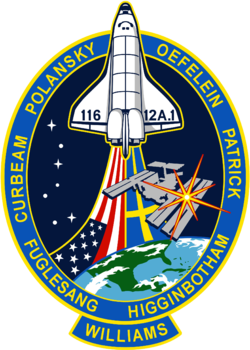Mark Lewis Polansky
| Mark Lewis Polansky | |
|---|---|
 Mark Lewis Polansky | |
| Astronaut NASA | |
| Státní příslušnost | |
| Datum narození | 2. června 1956 (66 let) |
| Místo narození | Paterson, New Jersey |
| Předchozí zaměstnání | pilot |
| Čas ve vesmíru | 41 dní, 10 hodin a 50 minut |
| Kosmonaut od | 1996 |
| Mise | STS-98, STS-116, STS-127 |
| Znaky misí | |
| Některá data mohou pocházet z datové položky. | |
Mark Lewis Polansky (* 2. června 1956 Paterson, stát New Jersey, USA) je letec, důstojník a americký kosmonaut. Ve vesmíru byl třikrát.
Život
Studium a zaměstnání
Absolvoval střední školu Johna P. Stevense ve městě Edison, New Jersey (1974) a pak pokračoval ve vysokoškolském studiu na Purdue University ve West Lafayete. Studium ukončil v roce 1978.
V letech 1996 až 1998 prodělal výcvik v Houstonu, po něm byl v květnu 1996 zařazen do jednotky kosmonautů v NASA.
Oženil se s Lisou, rozenou Ristowou. Měl přezdívku Roman.
Lety do vesmíru
Na oběžnou dráhu se v raketoplánech dostal třikrát a strávil ve vesmíru 41 dní, 10 hodin a 50 minut. Pracoval také na orbitální stanici ISS. Byl 398 člověkem ve vesmíru.
- STS-98 Atlantis (7. února 2001 – 16. února 2001), pilot
- STS-116 Discovery (10. prosinec 2006 – 22. prosinec 2006), velitel
- STS-127 Endeavour, (15. července 2009 – 31. července 2009), velitel
Odkazy
Externí odkazy
 Obrázky, zvuky či videa k tématu Mark Lewis Polansky na Wikimedia Commons
Obrázky, zvuky či videa k tématu Mark Lewis Polansky na Wikimedia Commons - Na webu Space
- Na webu Kosmo.cz
Média použitá na této stránce
This is the insignia for STS-98, which marks a major milestone in assembly of the International Space Station (ISS).
- Atlantis' crew will deliver the United States Laboratory, Destiny, to the ISS. Destiny will be the centerpiece of the ISS, a weightless laboratory where expedition crews will perform unprecedented research in the life sciences, materials sciences, Earth sciences, and microgravity sciences. The laboratory is also the nerve center of the Station, performing guidance, control, power distribution, and life support functions. With Destiny's arrival, the Station will begin to fulfill its promise of returning the benefits of space research to Earth's citizens.
- The crew patch depicts the Space Shuttle with Destiny held high above the payload bay just before its attachment to the ISS. Red and white stripes, with a deep blue field of white stars, border the Shuttle and Destiny to symbolize the continuing contribution of the United States to the ISS. The constellation Hercules, seen just below Destiny, captures the Shuttle and Station's team efforts in bringing the promise of orbital scientific research to life. The reflection of Earth in Destiny's window emphasizes the connection between space exploration and life on Earth.
The STS-116 patch design signifies the continuing assembly of the International Space Station (ISS). The primary mission objective is to deliver and install the P5 truss element. The P5 installation will be conducted during the first of three planned spacewalks, and will involve use of both the shuttle and station robotic arms. The remainder of the mission will include a major reconfiguration and activation of the ISS electrical and thermal control systems, as well as delivery of Zvezda Service Module debris panels, which will increase ISS protection from potential impacts of micro-meteorites and orbital debris. In addition, a single expedition crewmember will launch on STS-116 to remain onboard the station, replacing an expedition crewmember that will fly home with the shuttle crew. The crew patch depicts the space shuttle rising above the Earth and ISS. The United States and Swedish flags trail the orbiter, depicting the international composition of the STS-116 crew. The seven stars of the constellation Ursa Major are used to provide direction to the North Star, which is superimposed over the installation location of the P5 truss on ISS. The NASA insignia design for shuttle space flights is reserved for use by the astronauts and other official use as the NASA Administrator may authorize. Public availability has been approved only in the form of illustrations by the various news media. When and if there is any change in this policy, which is not anticipated, such will be publicly announced.
Space Shuttle mission STS-127 is the 32nd construction flight of the International Space Station (ISS) and the final of a series of three flights dedicated to the assembly of the Japanese "Kibo" laboratory complex. In addition to delivering, installing, and servicing an external scientific platform that will be attached to the end of the Japanese module, STS-127 will bring up a new ISS crew member and return another one to Earth, replace vital components of the ISS electrical production system, and transfer various pieces of hardware to ISS. Five spacewalks and the operation of four different robotic arms will be required to accomplish these tasks over 10 days. A crew spokesperson had the following words for the patch. "Bathed in sunlight, the blue Earth is represented without boundaries to remind us that we all share this world. In the center, the golden flight path of the space shuttle turns into the three distinctive rays of the astronaut symbol culminating in the star-like emblem characteristic of the Japanese Space Agency, yet soaring further into space as it paves the way for future voyages and discoveries for all humankind."
S98-00611 - Astronaut Richard A. Searfoss, STS-90 mission commander.




